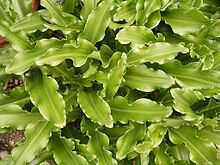| Veltheimia capensis | |
|---|---|

| |
| The Botanical Magazine, vol.14 | |
| Scientific classification | |
| Kingdom: | Plantae |
| Clade: | Tracheophytes |
| Clade: | Angiosperms |
| Clade: | Monocots |
| Order: | Asparagales |
| Family: | Asparagaceae |
| Subfamily: | Scilloideae |
| Genus: | Veltheimia |
| Species: | V. capensis |
| Binomial name | |
| Veltheimia capensis (L.) DC. | |
Veltheimia capensis is one of two species of flowering plants belonging to the genus Veltheimia, of the family Asparagaceae. It is a tender bulbous perennial reaching a height of 46 cm (18 in), with flowers varying in color from white with red spots to pink with green or red markings.
Morphology
Leaves of this plant are narrowly lance-shaped, thick and bluish green in color (see picture below). The average leaf size is 30 cm (12 in) long and 4 cm (1.6 in) across. The leaves retain their color throughout spring, summer and autumn. The leaves are in a whorled arrangement around the stem. Stems are also thick and are green in color, mixed with shades of purple. The most noticeable characteristic of the plant is its flower arrangement. Veltheimia capensis produces rosettes that are arranged in a raceme inflorescence that ultimately resembles a pendent-like shape. Individual flowers are tubular in shape and average 2–3 cm (~1in) in length. The flowers vary from white with red spots to pink with green or red markings. The plant generally flowers in spring and early summer.

Names
The specific epithet capensis refers to the Western Cape Province of South Africa, a native habitat for the plant. Common names include sand lily, elephant's eye and winter veltheimia.
Distribution
V. capensis grows naturally in the dry, arid climate of the northern part of the Western Province in south-western South Africa. Its distribution includes the rocky slopes of Namaqualand and extends through to parts of the Little Karoo.
Habitat and ecology
V. capensis germinates optimally at temperatures ranging from 19–24 °C (66–75 °F); however, it has also been known to grow in temperatures as low as 5–7 °C (41–45 °F). Soil conditions that are favorable for Veltheimia capensis are soils that are moderately fertile, well drained and experience a pH of 5.5-7.5. The composition of the soil is generally clay loam, , loamy sand, sandy clay loam and sandy loam.
Cultivation
The plant is valued as a drought-resistant ornamental, though with a minimum temperature of 5–7 °C (41–45 °F), in temperate regions it must be grown under glass. It has gained the Royal Horticultural Society's Award of Garden Merit.
See also
References
- ^ A-Z Encyclopedia of Garden Plants. New York, New York: DK publishing inc. 1997.
- ^ RHS A-Z encyclopedia of garden plants. United Kingdom: Dorling Kindersley. 2008. p. 1136. ISBN 978-1405332965.
- ^ Archived 2016-03-04 at the Wayback Machine
- "Veltheimia capensis". World Checklist of Selected Plant Families. Royal Botanic Gardens, Kew. Retrieved 2015-08-09.
- ^ "Pacific Bulb Society - Veltheimia capensis". Retrieved 7 June 2013.
- "RHS Plant Selector - Veltheimia capensis". RHS. Retrieved 5 March 2021.
- "AGM Plants - Ornamental" (PDF). Royal Horticultural Society. July 2017. p. 106. Retrieved 5 February 2019.
| Taxon identifiers | |
|---|---|
| Veltheimia capensis |
|
| Aletris capensis | |